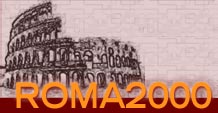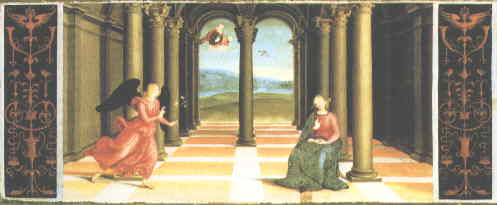
The Vatican Museums include:
EGYPTIAN MUSEUM
It consists of steleae and inscriptions from various ages, sarcophagi and mummies, Roman statuary (from the first and second century A.D.) designed to imitate or interpret the forms and aesthetics of Egyptian statuary, protohistoric and Roman ceramics, cuneiform tablets and mesopotamic seals, assirian bas-reliefs from the palaces of Sargon the IInd (722-705 B.C.) and Sennacherib (705-681 B.C.) in Nineveth.
CHIARAMONTI MUSEUM
It was founded by Pope Pius VII (Chiaramonti) and includes: the Corridoio (Corridor), the Galleria Lapidaria and the Braccio Nuovo (New Side). In the Corridor, divide into 60 sections, is an interminable series of statues, busts, sarcofhagi, reliefs, etc: about 800 Greek-Roman works. In the Galleria Lapidaria there are over 5000 pagan and Christian inscriptions. In the Braccio Nuovo, the Statue of Augustus of Prima Porta, the Group of the Nile and the Doriforos, deserve particular attention.
MUSEUM OF POPES CLEMENT XIV AND PIUS VI
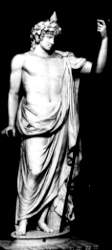 In the Palazzetto of Belvedere the visitor finds Greek and Roman sculptures like the Apollo Belvedere (a Roman copy from the original Greek sculpture, 130-140 A.D.), the famous group of Laocoön by Agesander, Polydorus and Athanodorus, the statue of Hermes (copied during Hadrian's reign from an original Greek bronze of 4th century B.C.), the colossal statue of Antinous (photo), and moreover the Canova's Cabinet, the Gallery of Statues, the Room of the Animals, etc. In the Palazzetto of Belvedere the visitor finds Greek and Roman sculptures like the Apollo Belvedere (a Roman copy from the original Greek sculpture, 130-140 A.D.), the famous group of Laocoön by Agesander, Polydorus and Athanodorus, the statue of Hermes (copied during Hadrian's reign from an original Greek bronze of 4th century B.C.), the colossal statue of Antinous (photo), and moreover the Canova's Cabinet, the Gallery of Statues, the Room of the Animals, etc.
GREGORIAN MUSEUM OF ETRUSCAN ART
FThe Etruscan Museum was founded by Gregory XIV in 1837 to house the works coming from the excavations carried out in southern Etruria. It was later enriched with further acquisitions and donations, and became one of the most important for Etruscan art.
ANTIQUARIUM ROMANUM
Divided into three small rooms, the Antiquarium houses mainly ancient Roman objects and works of the minor arts.
VASE COLLECTION
The collection consists of Greek and Etruscan black figure ceramics.
THE BIGA ROOM
This room, built during the pontificate of Pius VI (1775-99), is named after the Biga, the two-horse chariot located in the middle of the display area. The Roman Biga dates to the first century B.C.
GALLERY OF THE CANDELABRA
Once a loggia, the gallery was enclosed during the pontificate of Pius VI. Arches supported by columns and pillars were used to divide the space, which was then hung with candelabra, one for each arch: hence the name of the gallery.
GALLERY OF THE TAPESTRIES
Decorated during the pontificate of Pius VI, the gallery is named after the tapestries which were first exhibited there in 1814.
GALLERY OF THE MAPS
The Gallery is named after the maps painted on the walls in 40 different panels, each devoted to a region, island or particular territory of Italy.
APARTMENT OF ST.PIUS V
Gallery of St. Pius V: tapestries produced in Tournai in the middle of the sixteenth century and by Pieter van Aelst.
Chapel decorated with frescoes by Giorgio Vasari and Jacopo Zucchi.
SOBIESKI ROOM
Named for the painting which takes up the entire north wall with its depiction of the victory of John III Sobieski, King of Poland, over the Turks outside the walls of Vienna in 1683. The work was painted by Jan Matejko (1883).
ROOM OF THE IMMACULATE CONCEPTION
Located in the Borgia Tower, this room is decorated with frescoes by Francesco Podesti depicting scenes based on the dogma of the Immaculate Conception.
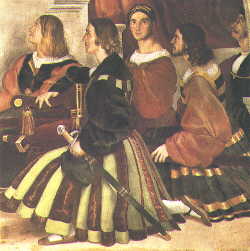 Raphael: Raphael:
The Bolsena Mass (detail)
RAPHAEL'S ROOMS AND LOGGIAS
The four rooms commonly known as the "Rooms of Raphael" were part of - togheter with the "Chiaroscuri" room, the Old Room of the Swiss, the cubicle with its adjoining heater, the Nicholine Chapel and the Loggia - the new residence chosen by Julius II on the third floor of the building.
The series of four communicating rooms was a reconstruction carried out by Nicholas V (1447-55) of the thirteenth century palace of Nicholas III (1277-80). Towards the end of the first decade of the sixteenth century Perugino, Sodoma, Baldassarre Peruzzi and Bramantino were all at work decorating them, but in 1509 Julius II dismissed them and commissioned Raphael to decorate the whole of this part of the Vatican. He worked there for about ten years, but only three of the rooms were completed before his death in 1520, and the direct intervention of the master is certain in only two of them.
COLLECTION OF MODERN RELIGIOUS ART
The collection includes Hundreds of paintings, sculptures, engravings and designs donated to the Holy See by private individuals and, in some cases, by the artists themselves. Housed in 55 different rooms, the exposition was inaugurated by Pope Paul VI in 1973. The itinerary begins in the Borgia Apartment, named for Alexander VI, who had the room decorated with the now famous frescoes, most of which are the work of either Pinturicchio or his students.
The collection includes works of Ottone Rosai, Auguste Rodin, Carlo Carrà, Mario Sironi, Aligi Sassu, Renato Guttuso, Marc Chagall, Paul Gauguin, Maurice Utrillo, Giorgio Morandi, Filippo de Pisis, Henry Moore, Paul Klee, Wassily Kandinsky, Georges Braque, Umberto Boccioni, Giacomo Balla, Giorgio De Chirico, Jacques Villon, Bernard Buffet, Oskar Kokoschka, Pablo Picasso, Francis Bacon, Diego Velasquez, etc.
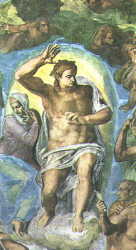 Michelangelo: Michelangelo:
Last Judgement,
Christ the Judge (detail)
SISTINE CHAPEL
Deservedly one of the most famous places in the world, the Sistine Chapel is the site where the conclave for the election of the popes and other solemn pontifical ceremonies are held. Built to the design of Baccio Pontelli by Giovannino de Dolci between 1475 and 1481, the chapel takes its name from Pope Sixtus IV, who commissioned it. It is a large rectangle with a barrel-vaulted ceiling and it is divided into two unequal parts by a marble screen. The screen and the transenna were built by Mino da Fiesole and other artists.
The frescoes on the long walls illustrate parallel events in the Lives of Moses and Christ and constitute a complex of extraordinary interest executed between 1481 and 1483 by Perugino, Botticelli, Cosimo Rosselli and Domenico Ghirlandaio, with their respective groups of assistants, who included Pinturicchio, Piero di Cosimo and others; later Luca Signorelli also joined the group.
The barrel-vaulted ceiling is entirely covered by the famous frescoes which Michelangelo painted between 1508 and 1512 for Julius II. The original design was only to have represented the Apostles, but was modified at the artist's insistence to encompass an enormously complex iconographic theme which may be synthesized as the representation of mankind waiting for the coming of the Messiah. More than twenty years later, Michelangelo was summoned back by Paul III (1534-49) to paint the Last Judgement on the wall behind the altar. He worked on it from 1536 to 1541.
APOSTOLIC LIBRARY
The Vatican Library was founded by Nicholas V (1447-55). Sixtus V (1585-90) commissioned the present building from Domenico Fontana, who built the long gallery and the Salone.
VATICAN PICTURE GALLERY
The Vatican Picture Gallery was founded by Pope Pius VI (1775-99). Only in 1932 was a permanent site established in a building commissionated by Pius XI (1922-39) from a design by the architect Luca Beltrami.
The gallery includes works of Giotto, Gentile da Fabriano, Beato Angelico, Perugino, Pinturicchio, Leonardo, Tiziano, Guercino, van Dyck, Poussin, etc.
GREGORIAN MUSEUM OF PROFANE ART
The special building constructed to house the museum (founded by Gregorius XVI in 1844) runs parallel to the Pinacoteca and was opened in 1970. The works are arranged according to didactic criteria, liberated as far as possible from arbitrary integration and excessive restorations. The four sections contain Roman copies and re-elaboration of Greek originals, Roman sculptures of repubblican and early imperial periods, sarcophagi, later Roman sculptures.
CHRISTIAN MUSEUM
Founded in 1854 by Pius IX in the Lateran Palace to house the Christian antiquities found during the excavations of the catacombs, the Museo Pio Cristiano was transferred to the Vatican in 1963.
MISSIONARY MUSEUM OF ETHNOLOGY
The material is vast and various and is presented according to didactic principles so as to document the religious cult of the various civilisation which have flourished in other continents over an enormous span of time, from centuries before the coming of Christ right up to our times.
CARRIAGE PAVILION
It was founded under the auspices of Paul VI and laid out in 1973 in a building constructed under the Square Garden.
The collection contains: the carriages of popes and cardinals, with various harnesses; graphic and photographic documentation of solemn processions containing berlins and carriages; black landaus for daily conveyance and the first automobiles used by the popes.
Address: Viale Vaticano
|
